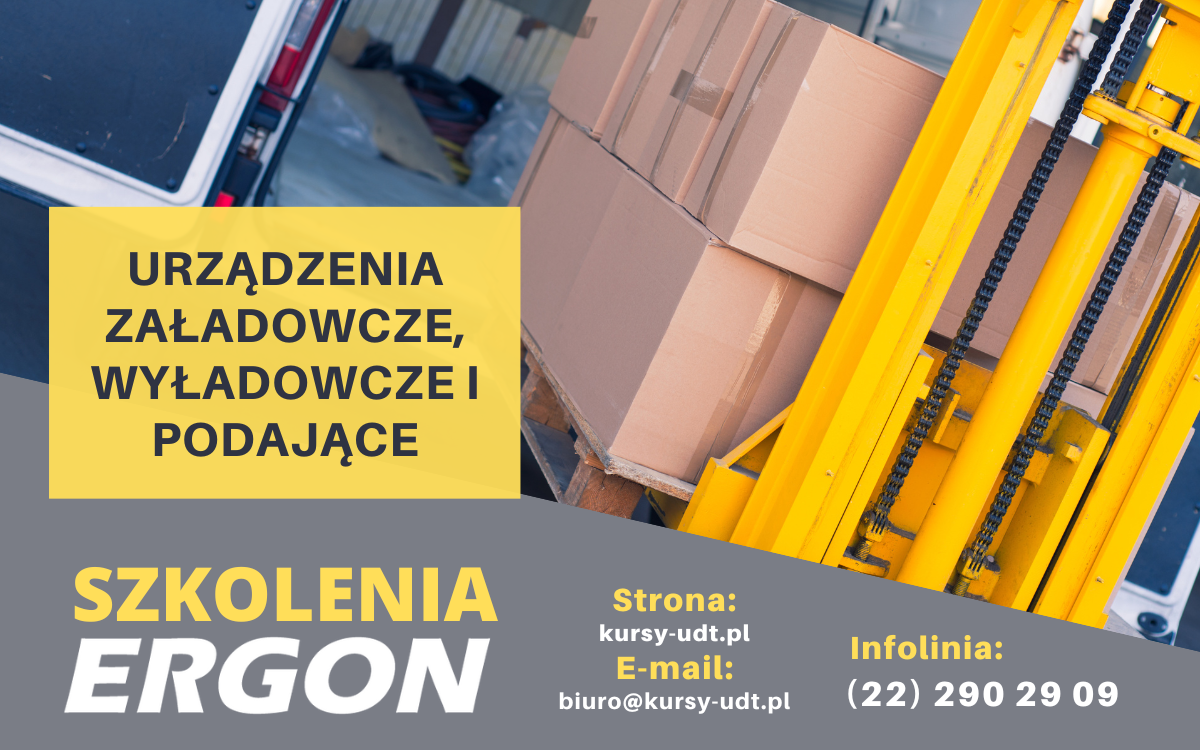Training in the operation of loading, unloading and feeding equipment
We organise a training course aimed at acquiring the necessary knowledge needed to perform loading and unloading operations. On successful completion of the training course and a successfully passed examination, participants receive a standard certificate authorising them to operate the equipment. The courses are designed for people who are new to loading and unloading equipment, but also for those wishing to improve their qualifications.

UDT qualifications
All loading, unloading or feeding equipment is subject to technical supervision. They may only be operated, maintained and repaired by highly qualified and experienced persons with entitlements granted by the Office of Technical Inspection. These authorisations can be obtained by undergoing training in the operation of these devices and then passing an examination before a commission from the Office of Technical Inspection. We have therefore developed ideal courses for the operation of loading, unloading or handling equipment. During our training courses, we guarantee professional training and a good chance of passing the exam on the first try.
Training program
Loading and unloading training includes a lecture-based course. We work closely with the Office of Technical Inspection, so it is easy to arrange examination dates to suit our clients' needs. During the course, students receive all the necessary teaching materials. Our instructors have many years of experience and many of them are experts in their field. Each participant can count on an individual approach.
The following topics are included in the training programme:

- labour protection and safety regulations,
- research into lifting and transport mechanisms,
- construction and operation of the device,
- fire safety rules,
- compliance with sanitary conditions and working methods,
- operator responsibilities,
- Health, Safety and Security.
The course provides detailed information including the principles of protection and safety when operating equipment. Participants in the course will be familiar with all the features of the equipment used in this type of work, will know how to position the vehicle and mechanisms correctly in the workplace and how to organise all processes properly.
Maintenance of loading, unloading and feeding devices
An important place among the maintenance activities for loading and unloading machinery is given to a system of preventive maintenance and repairs. Warehouse equipment, including loading and unloading equipment, needs to be regularly checked for malfunctions. Proper operation of machinery and loading and unloading equipment ensures high productivity and reliability. Minor damage, deterioration in performance can be repaired without major cost if detected in time.
Depending on the type of service, inspections and fault finding are carried out by both specially trained employees and service centre staff. The person directly responsible for the technical condition and its correct operation is the person who operates the machine entrusted to him. According to the standards in force, a preventive maintenance system is a set of interconnected tools and documentation necessary to maintain and restore the quality of machines under specific operating conditions. It is also a set of organisational and technical measures to ensure that the machine is kept in good working order, that operating costs are reduced and that the lowest cost of handling loads is achieved.
Maintenance is the set of activities that creates the most favourable operating conditions parts and subassemblies of the machine, preventing faults in good time and eliminating the defects detected. A repair is a series of technical operations aimed at removing faults that have arisen during the use of machinery.
Maintenance of storage equipment involves a series of operations that are carried out over a specific period of time. All work is regulated by the manufacturer and is reflected in the technical documents accompanying the equipment.
Inspection of equipment
Shift maintenance is carried out daily while the loading equipment is in operation, according to the manufacturer's recommendations. The operator checks the external and internal condition of each unit of the equipment, petrol level, oil, coolant, chassis and drives. Seasonal maintenance of the equipment takes place twice a year, usually in autumn and spring. Scheduled maintenance should be carried out according to the schedule in the manufacturer's technical documentation. It is carried out after a certain number of operating hours.

Loading, unloading and feeding devices
Loading, unloading and feeding equipment is used for loading, unloading and handling operations. The use of efficient equipment, allows commercial and warehouse companies to significantly optimise and streamline their operations. All processes are made simpler, without the risk of damaging the transport of goods. Depending on their purpose and scope of work, we can mention:
| Type | Description |
| loaders, forks | They are used to load a variety of materials onto transport equipment and place them in storage, as well as to move materials in warehouses during the sorting process and in the course of the production process. During operation, loaders perform material capture, movement and unloading. Depending on the type of work, we distinguish between cyclic and continuous machines. Cyclic loaders can be divided into general-purpose machines, which handle a wide range of bulk and general-purpose materials, and special machines, which are designed to handle a specific type of material only. |
| stackers | This equipment is used when it is necessary to lift and place loads at height. They are equipped with a lifting mechanism. Many different pavers are used in warehouse operations. There are electric, hydraulic, electromechanical, etc. stackers. |
We invite you to contact us and sign up for training!





























